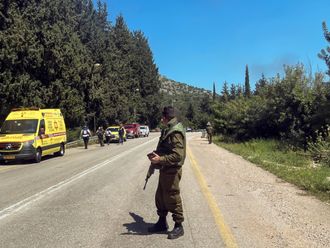Occupied Jerusalem: Missile-firing Israeli drones unlawfully killed at least 29 Palestinian civilians during the Gaza Strip war, Human Rights Watch said on Tuesday.
Despite having advanced surveillance equipment, drone operators failed to exercise proper caution "as required by the laws of war" in verifying their targets were combatants, the New York-based monitoring group said, issuing a 39-page report citing six alleged strikes by remote-controlled aircraft.
Israel has a fleet of spy drones, also known as unmanned aerial vehicles (UAVs), but does not discuss whether some of the pilot-less aircraft also carry weapons.
The armed forces issued a statement casting doubt on Human Rights Watch's research methods and asserting that all Israeli forces' combat actions "conform to international law, as do the weapons and munitions used."
Israel said it launched its December-January offensive to counter rocket fire from Hamas-ruled Gaza, and has since weathered foreign censure over the killing of some 1,400 Palestinians, many of them civilians, during the fighting.
Human Rights Watch based its findings primarily on debris from Israeli-made Spike missiles, which it said are fired from drones.
Spike's state-controlled manufacturer, Rafael Advanced Defence Systems Ltd, says the missile, which has been sold widely abroad, can be fired by helicopters, infantry units and naval craft.
Asked how it was possible to know that the Spikes in question had been fired by drones rather than these other means, Marc Garlasco, Human Rights Watch's senior military analyst, cited corroborative evidence such as Palestinian witnesses who said they had seen or heard the unmanned aircraft.
However, Garlasco conceded that two of the incidents cited took place in the evening or night, something that could potentially rule out anyone seeing the small and often high-flying aircraft.
Asked about the possibility an armed drone could be spotted solely from the distinctive buzz of its propellers, an Israeli defence official said surveillance drones had regularly patrolled Gaza during the war. "How could you tell what exactly you were hearing?" the official asked.
The Spike has a range of eight kilometres, Rafael says. The defence official said this could be enough to put the motors of a helicopter or a naval boat out of earshot, should they, not drones, be firing Spikes.













